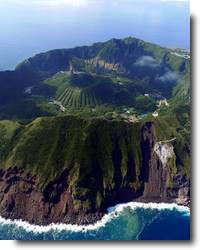Mount Yoshino In Japan
 Mount Yoshino (吉野山, Yoshinoyama), in Nara Prefecture, has been Japan's most famous cherry blossom viewing spot for many centuries. It is said that the first trees were planted along its slopes more than 1300 years ago, and today the mountain is covered by approximately 30,000 cherry trees of many different varieties, especially of the Yamazakura variety.
Mount Yoshino (吉野山, Yoshinoyama), in Nara Prefecture, has been Japan's most famous cherry blossom viewing spot for many centuries. It is said that the first trees were planted along its slopes more than 1300 years ago, and today the mountain is covered by approximately 30,000 cherry trees of many different varieties, especially of the Yamazakura variety.
Rather than a free standing mountain, Yoshinoyama is a north-facing mountain slope. It is divided into four areas: the Shimo Senbon (lower 1000 trees) at the base of the mountain, Naka Senbon (middle 1000 trees), Kami Senbon (upper 1000 trees) and Oku Senbon (inner 1000 trees) at the top of the mountain. Visitors can enjoy the cherry trees as they ascend the mountain, passing Yoshino's touristy town with its various temples and shrines, and enjoying hanami in the parks and viewpoints along the way.
 Yoshinoyama's cherry blossoms typically start opening in late March or early April and reach full bloom around early to mid April. Because of the range of elevation, the blooming season is staggered by a couple of days between the Shimo (lower), Naka (middle) and Kami (upper) Senbon areas as the blossom front gradually moves up the mountain. The trees in the Oku Senbon area open considerably later. Be warned that depending on the weather, the starting date and length of the season can vary quite a bit from year to year.
Yoshinoyama's cherry blossoms typically start opening in late March or early April and reach full bloom around early to mid April. Because of the range of elevation, the blooming season is staggered by a couple of days between the Shimo (lower), Naka (middle) and Kami (upper) Senbon areas as the blossom front gradually moves up the mountain. The trees in the Oku Senbon area open considerably later. Be warned that depending on the weather, the starting date and length of the season can vary quite a bit from year to year.
The Shimo Senbon (lower) area encompasses the base of the mountain around Yoshino Station and the lower part of the town. The Yoshino Ropeway bypasses the steep ascent between the station and the town, but waiting times for the ropeway can get very long during the peak of the season. Lots of cherry trees are planted along the road up to the town, making the ascent on foot an attractive alternative to the ropeway.

Yoshino seen from the Hanayagura viewpoint
Mount Yoshino (吉野山, Yoshinoyama), in Nara Prefecture, has been Japan's most famous cherry blossom viewing spot for many centuries. It is said that the first trees were planted along its slopes more than 1300 years ago, and today the mountain is covered by approximately 30,000 cherry trees of many different varieties, especially of the Yamazakura variety.
Rather than a free standing mountain, Yoshinoyama is a north-facing mountain slope. It is divided into four areas: the Shimo Senbon (lower 1000 trees) at the base of the mountain, Naka Senbon (middle 1000 trees), Kami Senbon (upper 1000 trees) and Oku Senbon (inner 1000 trees) at the top of the mountain. Visitors can enjoy the cherry trees as they ascend the mountain, passing Yoshino's touristy town with its various temples and shrines, and enjoying hanami in the parks and viewpoints along the way.

Cherry trees line the road through the town in the Shimo Senbon area before the arrival of the daytime crowds
Yoshinoyama's cherry blossoms typically start opening in late March or early April and reach full bloom around early to mid April. Because of the range of elevation, the blooming season is staggered by a couple of days between the Shimo (lower), Naka (middle) and Kami (upper) Senbon areas as the blossom front gradually moves up the mountain. The trees in the Oku Senbon area open considerably later. Be warned that depending on the weather, the starting date and length of the season can vary quite a bit from year to year.
The Shimo Senbon (lower) area encompasses the base of the mountain around Yoshino Station and the lower part of the town. The Yoshino Ropeway bypasses the steep ascent between the station and the town, but waiting times for the ropeway can get very long during the peak of the season. Lots of cherry trees are planted along the road up to the town, making the ascent on foot an attractive alternative to the ropeway.

The view from Yoshimizu Shrine
The Naka Senbon (middle) area covers the rest of the town along the ridge of the mountain. This is where the majority of Yoshino's accommodations, shops, restaurants, temples and shrines are found, including Kinpusenji Temple and Yoshimizu Shrine. The view up the mountain from Yoshimizu Shrine is particularly famous.
Towards the top of the Naka Senbon area lies the Naka Senbon Park, one of the most attractive spots for holding hanami picnics under the trees. The park spans several small hills that are covered by cherry trees and offer views onto even more cherry trees. Especially in good weather, the atmosphere here is delightful.


